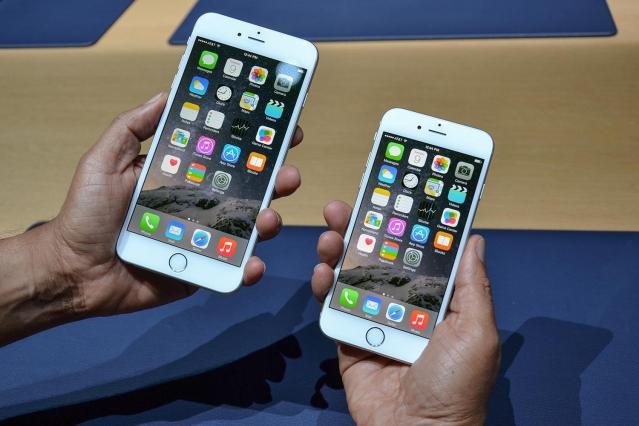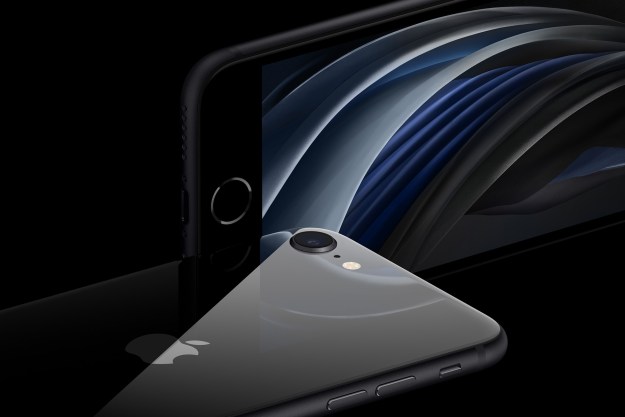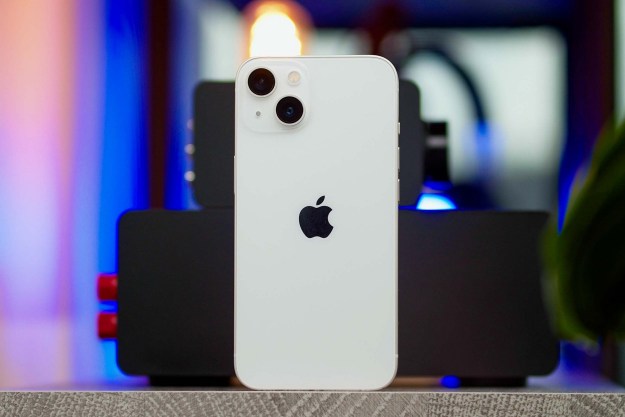We get it, people talk about the Google Play Store and you ask which mall it’s in. You watched the Apple press conference, you downloaded the U2 album, and you’ve bought way too many games on the Apple App Store to even consider switching mobile platforms. What’s important to you is knowing how the new iPhones stack up against each other. The iPhone 6 and 6 Plus bring a number of notable improvements to the successful line, as well as offering a choice of two different form factors in an effort to stay relevant, despite only releasing a new phone every year or so.
|
Apple iPhone 6 |
Apple iPhone 6 Plus |
|
| Size | 5.44 x 2.64 x .27 inches | 6.22 x 3.06 x .28 inches |
| Weight | 4.55 ounces | 6.07 ounces |
| Screen | 4.7-inch | 5.5-inch |
| Resolution | 1334 x 750 pixels | 1920 x 1080 pixels |
| OS | iOS 8 | iOS 8 |
| Storage | 16, 64, 128GB | 16, 64, 128GB |
| SD Card Slot | No | No |
| Processor | Apple 64-bit, A8 | Apple 64-bit, A8 |
| RAM | 1GB (Speculation) | 2GB (speculation) |
| Connectivity | 4G LTE, 802.11ac | 4G LTE, 802.11ac |
| Camera | 8MP rear, 2.1MP front | 8MP rear, 2.1MP front |
| Bluetooth | 4.0 | 4.0 |
| Fingerprint sensor | Touch ID | Touch ID |
| Water Resistant | Yes | Yes |
| Battery | 14 hours of talk time | 24 hours of talk time |
| Charger | Lightning | Lightning |
| Marketplace | Apple App Store | Apple App Store |
| Avg. Price | $650, $200 with 2-year contract | $750, $300 with 2-year contract |
| Availability | September 19th on AT&T, Verizon, Sprint, T-Mobile | September 19th on AT&T, Verizon, Sprint, T-Mobile |
| DT Review | 4.5 out of 5 stars | 4.5 out of 5 stars |
Size
Even though the difference in diagonal screen size is less than an inch between the two iPhone 6 models, this translates into a very noticeable difference when you hold the device. If you value screen real estate, and frequently find yourself wanting to read and respond to emails in landscape mode, the iPhone 6 Plus has a number of features that take advantage of the larger display. The email and messages, as well as the home screen, have been updated to include landscape versions, much like the last few generations of iPad. In addition, the larger iPhone 6 Plus has a one-handed mode that shifts applications down toward the bottom of the display, solving the problem that a lot of users complain about with larger smartphones.
Related: See exactly how big the iPhone 6 and 6 Plus are in these size comparison photos.
Winner: iPhone 6
(The smaller footprint is much more comfortable for phone use and texting, at least until we’ve had a chance to play with the one-hand mode on the Plus.)

Design
Apple’s design philosophy has always revolved around a utilitarian simplicity, and the iPhone 6 is no exception. The glass edges of the screen wrap around the edge, making both models significantly more comfortable to hold than the iPhone 5, as well as taking care of the phone ghost that the sharper edges left on jeans. In addition to the gold and silver makeups, the iPhone 6 is also available in space gray, a darker matted slate color that has appeared in previous generations of iPhone and iPod.
Winner: Tie
(The changes made to the iPhone 6’s design has made both models thinner and lighter than iPhone 5S)
Processing power
Apple’s new A8 processor is a huge jump in performance from the A7, but by how much is still unknown. While most processors deal in concrete numbers like speed in GHz and number of cores, the A8 system on a chip is only defined, at this point, by its comparison to the older A7. What we do know, is that the A7 chip found in the iPhone 5 is a dual-core processor that has a maximum clock rate of about 1.4 GHz, with a 28nm construction. Apple boasts that the A8 chip has a 20nm construction, which means that it should be much more power efficient. Chances are we won’t know more about the A8 until it’s in our hands and we can run benchmarks, but according to Apple the new chip has a 25 percent improvement in CPU performance, 50 percent in graphical performance, and draws half the power of the old chip. While the A8 processor likely packs in 1GB of RAM standard, there’s some speculation that the iPhone 6 Plus will feature a hefty 2GB of memory to support the larger display and some of the functionality, but that hasn’t been confirmed by Apple.
Winner: iPhone 6 Plus
(Whether or not it has the extra GB of RAM, Apple always crafts a seamless hardware and software experience, and the fact that the processor can run Metal on a 1080p screen is impressive.)

Battery life
You might think that the big increase in screen size and resolution from the iPhone 6 to the iPhone 6 Plus would cause a drop in battery life, but Apple took advantage of the larger construction by increasing the capacity of the battery. Not only do both phones mark a noticeable increase in battery life from the previous generation, but the iPhone 6 Plus boasts almost twice the 3G talk time of the standard model. That being said, chances are the higher performance demands, increased RAM, and larger screen will ultimately cause the battery life when playing games or using battery-intensive apps to drain a lot faster on the larger version.
Winner: iPhone 6 Plus
(Let’s be honest, both phones are probably going to need a charge every night to make it through the day, but there’s a notable bump in power efficiency even with the larger display.)
Price
Apple has never been known for especially budget-minded devices, and the newest family of iPhones doesn’t veer from that trend. They aren’t unreasonably priced on a contract, with the iPhone 6 starting at $200 for the 16 GB, all the way up to $400 for the standard 128 GB storage build. The iPhone 6 Plus has the same pricing model, except at $100 more at each storage level. What do you get for that $100 upgrade to the iPhone 6 Plus? The larger screen makes up a large chunk of that upgrade money, and is also the most immediately noticeable difference between the two phones. Other than that, the cost increase goes toward solving some of the issues that arise when you bump screen size and resolution. There’s a little more room for the camera sensor, which allows for the inclusion of a moving lens, but the larger battery is mostly to make up for the display, which is usually the most battery-draining component in a smartphone.
Expect to be wooed by the major carriers with all sorts of offers to trade in your current iPhone or switch from your carrier to them for free iPhones, or at least a big discount. By far the least economical of these plans charge a monthly fee, like the AT&T Next plan or the Verizon Edge subscription service. By the time the two years are over and you’ve paid off the monthly fees, you’re likely to have paid more than the phone costs at full retail, and three or four times more than if you signed up for a new contract. Without taking into consideration all of the incentives that carriers are offering, here are the prices for the different models of iPhone 6, both with a contract agreement and unlocked.
| 16 GB | 64 GB | 128 GB | |
| iPhone 6 – With contract | $199 | $299 | $399 |
| iPhone 6 – Unlocked | $649 | $749 | $849 |
| iPhone 6 Plus – With contract | $299 | $399 | $499 |
| iPhone 6 Plus – Unlocked | $749 | $849 | $949 |
Winner: iPhone 6
(Apple smartphones usually end up costing more than their Android competitors, but at $300 for a 64 GB version of the standard iPhone 6, they’re getting closer to the rest of the market.)

Connectivity
Both new iPhones feature an improved LTE antenna that allows supports transfer speeds of up to 150Mbps, a significant increase in speed over the iPhone 5S. By supporting up to 20 LTE bands, seven more than the 5S, the iPhone 6 has more than any other smartphone in production today, opening up a much wider band of available networks while increasing stability while browsing the Web or streaming music from the cloud. With 802.11ac support, you’ll also experience Wi-Fi speeds up to three times faster than 802.11n, and Bluetooth LE for lower power consumption when using Bluetooth devices.
Winner: Tie
(The iPhone 6 and iPhone 6 Plus both have more LTE bands and a stronger antenna than almost any other phone on the market.)
Display
While neither display is particularly cutting-edge in terms of resolution, especially when compared to other Android smartphones on the market, but one of the key differences is in the sheer amount of time Apple spends on its user interface. In addition to having strict regulations regarding responsiveness and appearance in apps submitted to the app store, Apple also spends an inordinate amount of time ensuring that every time you touch the screen on your phone, it looks and feels perfect.
There are stories from the creation of iOS where developers would spend several hours in a meeting discussing the placement of individual pixels in the corner of their screens. The newest version of the operating system, iOS 8, is sure to have a number of improvements that will take advantage of the higher resolution displays in then iPhone 6 line. That being said, the iPhone 6 Plus screen is certainly preferable to the standard iPhone 6 screen, if you don’t mind the phone being an extra half-inch wide. With a 1920 x 1080 pixel resolution on a 5.5-inch display, the iPhone 6 will look great running any app, as well as enjoying HD movies.
Winner: iPhone 6 Plus
(Apple’s retina display technology has always been a trademark of the devices, and the bigger full HD display on the iPhone 6 Plus is no exception.)
Camera
Both of the new models of iPhone 6 feature an improved 8 megapixel sensor that takes advantage of plane-shift autofocus, a technology built into a number of high-end digital cameras that provides quick and accurate focusing. The result is a camera that takes sharper images, and is much more responsive, but the iPhone 6 Plus has a little extra trick up its sleeve. While digital image stabilization uses complex calculations and algorithms to sharpen up blurry images, gyroscopes in the iPhone 6 Plus camera sense movement and physically move the lens to prevent fuzziness. The result is an incredibly stable shot, even in tumultuous conditions, or while taking long-exposure shots in low light.
Winner: iPhone 6 Plus
(Optical image stabilization is going to make every video and photo captured focus faster and look sharper.)
Sensors
Both of the iPhone 6 models feature the M8 motion coprocessor, a chip that not only houses the standard set of accelerometers and gyroscopes, but also tracks fitness and motion measurements to the point of being able to tell whether you’re standing or walking up and down stairs. This kind of acute tracking improves the performance of the Nike+ app, but also allowed Apple to create the healthbook software that encourages you to move, exercise, and stand for a few minutes each day. The M8 coprocessor also introduced a barometer and relative elevation sensor for measuring elevation changes while working out or getting a more precise weather forecast.
Winner: Tie
(The M8 motion coprocessor that’s included with both version of the iPhone 6 tracks a bevy of metrics, and you’ll get use out of it whether you get the iPhone 6 or the iPhone 6 Plus.)
Key differences and conclusion
When it comes down to it, the choice between the iPhone 6 and the iPhone 6 Plus is one that’s going to be determined by your specific needs, and how you use your smartphone. The iPhone 6 Plus comes with vastly improved battery life over the iPhone 6, as well as optical image stabilization and a 1080p display, but it’s massive. If you’re a power user who is constantly emailing and using your phone to take high quality photos, it might be worth splurging for the Plus. For most users, however, the iPhone 6 will be a welcome upgrade to that old iPhone 5 that needs its battery replaced, and offers a competitive way to stay up to date if you’re already embedded in the Apple ecosystem.
Overall Winner: iPhone 6 Plus (Except for comfort due to its large size)
Related: iPhone 6 Plus vs. Galaxy Note 4.
Related: iPhone 6 vs. Galaxy S5.
Related: How big is the iPhone 6 Plus?
Editors' Recommendations
- One of the most iconic iPhone accessories is back — and it’s great
- Are you having iPhone alarm problems? A fix is coming soon
- How to turn off call forwarding on iPhone and Android
- How to transfer photos from an iPhone to a computer
- How to schedule a text message on your iPhone





